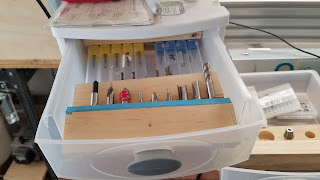Chomping at the Bit

Bits Everywhere! I got tired of chasing my bits around the surfaces of my CNC and decided to organize them. Now I have a 3 drawer chest that holds my bits in separate wooden sections organized by bit type. I plan to mark the bits with #'s that correlate with my tool library in F360. I wanted to keep the holders that come with some bits because I like how they protect the bit. For these cases I glued the bottom of the holder into a slot I milled into the wood holder. I found that gluing a piece of foam at the top edge of the holders help to keep the bits from falling out. We will see if this solves my problem :). Enjoy and comment, Don

